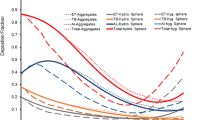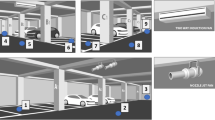Abstract
Atmospheric photochemical reactions of vehicular primary emissions result in the formation of secondary organic aerosol (SOA). This is the first study that has investigated the toxicity of secondary particles based on fleet vehicular emissions. We developed methods for photochemical oxidation of traffic primary emissions to produce mixtures of primary and/or secondary particles suitable for animal exposures. The exposure generation system produced test atmospheres of primary (P), aged primary plus SOA (P + SOA), or SOA particles suitable for animal exposures. The system consists of (1) a sampling system to extract the traffic emissions from the plenum of a highway tunnel ventilation stack, (2) a photochemical chamber to simulate atmospheric aging, and (3) a nonselective diffusion denuder to remove gaseous pollutants prior to exposure. In the presence of traffic primary particles (P + SOA), a longer mean residence time resulted in a higher SOA yield. Higher baseline plenum primary particle mass concentration resulted in lower SOA yield. In the absence of primary particles (SOA), higher plenum gas concentrations resulted in higher SOA yield. Secondary aerosol was largely organic but contained some nitrate and sulfate. Formation of secondary aerosol is influenced significantly by reaction of primary gases with ·OH. The system (1) provides adequate flow and stable chamber output of P, P + SOA, and SOA for characterization and animal exposures and (2) generates reproducible exposure atmospheres of P, P + SOA, and SOA, all at consistent mass concentrations.





Similar content being viewed by others
Abbreviations
- BC:
-
Black carbon
- CAPs:
-
Concentrated ambient particles
- O3 :
-
Ozone
- SOA:
-
Secondary organic aerosol
- TERESA:
-
Toxicological Evaluation of Realistic Emission Source Aerosols
- CO:
-
Carbon monoxide
- NO x :
-
Nitrogen oxides
- FEP:
-
Fluorinated ethylene propylene
- PFA:
-
Polyfluorinated alkene
- UV:
-
Ultraviolet
- HEPA:
-
High-efficiency particulate air
- ·OH:
-
Hydroxyl radical
- MRT:
-
Mean residence time
- VOCs:
-
Volatile organic compounds
- NO:
-
Nitric oxide
- SMPS:
-
Scanning Mobility Particle Sizer
- CPC:
-
Condensation Particle Counter
- APS:
-
Aerodynamic Particle Sizer
- EC/OC:
-
Elemental carbon and organic carbon
- TOR:
-
Thermal optical reflectance
- PM:
-
Particle mass
- PyrolC:
-
Pyrolyzed organic carbon concentration
- NO2 :
-
Nitrogen dioxide
- HNO3 :
-
Nitric acid
- NH3 :
-
Ammonia
- NH4NO3 :
-
Ammonium nitrate
- ·NO3 :
-
Nitrate radical
- [NH4]2SO4 :
-
Ammonium sulfate
- OC:
-
Organic Carbon
- SO2 :
-
Sulfur dioxide
- H2SO4 :
-
Sulfuric acid
References
Allen JO, Mayo PR, Hughes LS, Salmon LG, Cass GR (2001) Emissions of size segregated aerosols from on-road vehicles in the Caldecott tunnel. Environ Sci Technol 35:4189–4197
Baccarelli A, Martinelli I, Pegoraro V, Melly S, Grillo P, Zanobetti A, Kou L, Bertazzi A, Manucci PM, Schwartz J (2009) Living near major traffic roads and risk of deep vein thrombosis. Circulation 119:3118–3124
Batalha JRF, Saldiva PHN, Clarke RW, Coull BA, Stearns RC, Lawrence J, Krishna Murthy GG, Koutrakis P, Godleski JJ (2002) Concentrated ambient air particles induce vasoconstriction of small pulmonary arteries in rats. Env Health Perspect 110:1191–1197
Canagaratna MR, Jayne JT, Ghertner DA, Herndon S, Shi Q, Jimenez JL, Silva PJ, Williams P, Lanni T, Drewnick F, Demerjian KL, Kolb CE, Wornshop DR (2004) Chase studies of particulate emissions from in-use New York City vehicles. Aerosol Sci Technol 38:555–573
Chow JC, Watson JG, Pritchett LC, Pierson WR, Frazier CA, Purcell RG (1993) The DRI thermal/optical reflectance carbon analysis system: description, evaluation and applications in U.S. air quality studies. Atmos Environ 27A:1185–1201
Clarke RW, Coull B, Reinisch U, Catalano P, Killingsworth CR, Koutrakis P, Kavouras I, Murthy GGK, Lawrence J, Lovett E, Wolfson JM, Verrier RL, Godleski JJ (2000) Inhaled concentrated ambient particles are associated with hematologic and broncholveolar lavage changes in canines. Environ Health Perspect 108(12):1179–1187
Demokritou P, Kavouras IG, Ferguson ST, Koutrakis P (2002) Development of a high volume cascade impactor for toxicological and chemical characterization studies. Aerosol Sci Tech 36:925–933
Diaz EA, Chung Y, Papapostolou V, Lawrence J, Long MS, Hatakeyama V, Gomes B, Calil Y, Sato R, Koutrakis P, Godleski JJ (2012a) Effects of fresh and aged vehicular exhaust emissions on breathing pattern and cellular responses—pilot single vehicle study. Inhal Toxicol 24(5):288–295
Diaz E A, Chung Y, Lamoureux D P, Long MS, Papapostolou V, Lawrence J, Mazzaro V, Buonfiglio H, Oliveira J P, Sato R, Koutrakis P, Godleski JJ (2012b) Effects of fresh and aged traffic-related particles on breathing pattern, cellular responses and oxidative stress. Air Quality Atmosphere and Health (in press)
Dolinay T, Szilasi M, Siu M, Choi AMK (2004) Inhaled carbon monoxide confers anti-inflammatory effects against ventilator-induced lung injury. Am J Respir Crit Care Med 170:613–620
Gertler AW, Wittorff DN, McLaren R, Belzer W, Dann T (1997) Characterization of vehicle emissions in Vancouver BC during the 1993 Lower Fraser Valley oxidants study. Atmos Environ 31:2107–2112
Gianetti J, Bevilacqua S, De Caterina R (2002) Inhaled nitric oxide: more than a selective pulmonary vasodilator. Eur J Clin Invest 32(8):628–635
Godleski JJ, Diaz E, Lemos M, Long M, Ruiz P, Gupta T, Kang CM, Coull B (2011a) Toxicological Evaluation of Realistic Emission Source Aerosols (TERESA)-power plant studies: assessment of cellular responses. Inhal Toxicol 23:60–74
Godleski JJ, Koutrakis P, Kang CM, Diaz E, Rohr AC (2011b) Toxicological Evaluation of Realistic Emission Source Aerosols (TERESA): introduction and overview. Inhal Toxicol 23:1–10
Godleski JJ, Rohr AC, Coull BA, Kang CM, Diaz EA, Koutrakis P (2011c) Toxicological evaluation of realistic emission source aerosols (TERESA): summary and conclusions. Inhal Toxicol 23:95–103
Hatakeyama S, Kobayashi H, Akimoto H (1984) Gas-phase oxidation of SO2 in the ozone-olefin reactions. J Phys Chem 88:4736–4739
Hinners RG (1962) Engineering the chronic exposure of animals to laboratory produced automobile exhaust. J Air Pollut Contr Assoc 12:527–530
Hueter FG et al (1966) Biological effects of atmospheres contaminated by auto exhaust. Arch Environ Health 12:553
Kang CM, Koutrakis P, Suh HH (2010) Hourly measurements of fine particulate sulfate and carbon aerosols at the Harvard-U.S. Environmental Protection Agency Supersite in Boston. J Air Waste Manag Assoc 60:1327–1334
Kim HP, Ryter SW, Choi AM (2006) CO as a cellular signaling molecule. Annu Rev Pharmacol Toxicol 46:411–449. doi:10.1146/annurev.pharmtox.46.120604.141053
Laden F, Neas LM, Dockery DW, Schwartz J (2000) Association of fine particulate matter from different sources with daily mortality in six U.S. cities. Environ Health Perspect 108:941–947
Lamoureux D P, Diaz E A, Chung Y S, Coull B, Papapostolou V, Lawrence J, Sato R, Oliveira J P, Godleski JJ (2012) Effect of fresh and aged vehicular particulate emissions on blood pressure in normal adult male rats. Air Quality Atmosphere and Health (in press)
Lewis TR, Hueter FG, Busch KA (1967) Irradiated automobile exhaust. Its effects on reproduction of mice. Arch Environ Health 15:26
Miller MR, Borthwick SJ, Shaw CA, McLean SG, McClure D, Mills NL, Duffin R, Donaldson K, Megson IL, Hadoke PWF, Newby DE (2009) Direct impairment of vascular function by diesel exhaust particulate through reduced bioavailability of endothelium-derived nitric oxide induced by superoxide free radicals. Environ Health Perspect 117:611–616
Mordukhovich I, Wilker E, Suh H, Wright R, Sparrow D, Vokonas PS, Schwartz J (2009) Black carbon exposure, oxidative stress genes, and blood pressure in a repeated-measures study. Environ Health Perspect 117:1767–1772
Morse D, Choi AM (2008) Inhaled CO in the treatment of acute lung injury. Am J Physiol Lung Cell Mol Physiol 294(4):L642–L643. doi:10.1152/ajplung.00054.2008
Murphy SD et al (1963) Effects on animals of exposure to auto exhaust. Arch Environ Health 7:60
Nel A (2005) Air pollution—related illness: effects of particles. Science 308:804–806
Papapostolou V, Lawrence JE, Diaz EA, Wolfson JM, Ferguson ST, Long MS, Godleski JJ, Koutrakis P (2011a) Laboratory evaluation of a prototype photochemical chamber designed to investigate the health effects of fresh and aged vehicular exhaust emissions. Inhal Toxicol 23:495–505
Papapostolou V, Lawrence JE, Ferguson ST, Wolfson JM, Koutrakis P (2011b) Development and evaluation of a countercurrent parallel-plate membrane diffusion denuder for the removal of gas-phase compounds from vehicular emissions. Inhal Toxicol 23:853–862
Peters A, von Klot S, Heier M, Trentinaglia I, Hormann A, Wichmann E, Hannelore L (2004) Exposure to traffic and the onset of myocardial infarction. N Engl J Med 351:1721–1730
Putaud JP, Raes F, Van Dingenen R, Brüggemann E, Facchini MC, Decesari S, Fuzzi S, Gehrig R, Hüglin C, Laj P, Lorbeer G, Maenhaut W, Mihalopoulos N, Müller K, Querol X, Rodriguez S, Schneider J, Spindler G, ten Brink H, Tørseth K, Wiedensohler A (2004) A European aerosol phenomenology-2: chemical characteristics of particulate matter at kerbside, urban, rural and background sites in Europe. Atmos Environ 38:2579–2595
Reed MD, Gigiliotti AP, McDonald JD, Seagrave JC, Seilkop SK (2004) Health effects of subchronic exposure to environmental levels of diesel exhaust. Inhal Toxicol 16:177–193
Ryter SW, Morse D, Choi AM (2004) Carbon monoxide: to boldly go where NO has gone before. Sci STKE 2004(230):RE6. doi:10.1126/stke.2302004re6
Sage AM, Weitkamp EA, Robinson AL, Donahue NM (2008) Evolving mass spectra of the oxidized component of organic aerosol: results from aerosol mass spectrometer analyses of aged diesel emissions. Atmos Chem Phys 8:1139–1152
Saldiva PHN, Clarke RW, Coull BA, Stearns R, Lawrence J, Koutrakis P, Suh H, Tsuda A, Godleski JJ (2002) Acute pulmonary inflammation induced by concentrated ambient air particles is related to particle composition. Am J Respir Crit Care Med 165:1610–16172
Sethi JM, Choi AM, Calhoun WJ, Ameredes BT (2008) Non-invasive measurements of exhaled NO and CO associated with methacholine responses in mice. Respir Res 9:45. doi:10.1186/1465-9921-9-45
Schwartz J, Suh H, Verrier M et al (2001) Fine combustion particles and heart rate variability in an elderly panel. Epidemiol 12(4):S64
Suglia SF, Gryparis A, Schwartz J, Wright RJ (2008) Association between traffic-related black carbon exposure and lung function among urban women. Environ Health Perspect 116(10):1333–1337
Weitkamp EA, Sage AM, Pierce JR, Donahue NM, Robinson AL (2007) Organic aerosol formation from photochemical oxidation of diesel exhaust in a smog chamber. Environ Sci Technol 41:6969–6975
Wellenius GA, Batalha JRF, Diaz EA, Lawrence J, Coull BA, Katz T, Verrier RL, Godleski JJ (2004) Cardiac effects of carbon monoxide and ambient particles in a rat model of myocardial infarction. Toxicol Sci 80:367–376
Zanobetti A, Stone PH, Speizer FE, Schwartz J, Coull BA, Suh HH, Nearing BD, Mittleman MA, Verrier RL, Gold DR (2009) T-Wave alternans, air pollution and traffic in high-risk subjects. Am J Cardiol 104:665–670
Zielinska B, Samy S, McDonald JD, Seagrave JC (2010) Atmospheric transformation of diesel emissions. Research report. Health Effects Institute no. 147
Acknowledgments
This publication was made possible by USEPA grants R-832416 and RD 83479801. Its contents are solely the responsibility of the grantee and do not necessarily represent the official views of the USEPA. Further, USEPA does not endorse the purchase of any commercial products or services mentioned in the publication. This work was also supported by the Harvard NIEHS Center for Environmental Health (grant P30ES00002). We thank Dr. Stephen Rudnick for reading the manuscript and providing helpful suggestions. We also thank Elena Austin, Samuel Pueringer, and Dr. Choong-Min Kang for technical assistance and/or analytical support.
Author information
Authors and Affiliations
Corresponding author
Electronic supplementary material
Below is the link to the electronic supplementary material.
ESM 1
(DOCX 28.8kb)
Rights and permissions
About this article
Cite this article
Papapostolou, V., Lawrence, J.E., Ferguson, S.T. et al. Development and characterization of an exposure generation system to investigate the health effects of particles from fresh and aged traffic emissions. Air Qual Atmos Health 6, 419–429 (2013). https://doi.org/10.1007/s11869-012-0178-3
Received:
Accepted:
Published:
Issue Date:
DOI: https://doi.org/10.1007/s11869-012-0178-3




